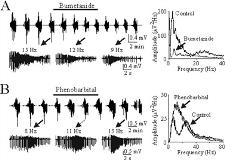BUMETANIDE FOR NEONATAL SEIZURE THERAPY
Abstract number :
2.011
Submission category :
Year :
2004
Submission ID :
4534
Source :
www.aesnet.org
Presentation date :
12/2/2004 12:00:00 AM
Published date :
Dec 1, 2004, 06:00 AM
Authors :
Volodymyr I. Dzhala, Den A. Sdrulla, Audrey C. Brumback, and Kevin J. Staley
GABA is the primary inhibitory neurotransmitter in adult mammalian brain. However, in neonates activation of Cl--permeable GABA receptors excites many neurons and appears to depend on the expression of a Na+-K+-2Cl- cotransporter (NKCC1) that elevates intracellular Cl- levels, leading to a depolarized Cl- equilibrium potential (E[sub]Cl[/sub]). Excitatory actions of GABA contribute to initiation of ictal epileptiform activity in the developing hippocampus (Dzhala and Staley, 2003) and it is not surprising then that the barbiturates and benzodiazepines, drugs that increase GABA effects, fail to suppress the EEG seizures in the immature brain. A reasonable alternative would be to use drugs that work at other sites. Neonates accumulate Cl- through the action of a NKCC1 cotransporter, which is exquisively sensisitive to the diuretic bumetanide. We propose to use bumetanide to alter the ion gradients that underlie the excitatory effects of GABA to inhibit the neonatal brain in order to improve the therapy of neonatal seizures. Whole-cell and extracellular array recordings were used to study the efficacy of diuretic bumetanide in the treatment of high (8.5 mM) extracellular potassium induced ictal-like epileptiform activity in the immature (postnatal day (P) 7-15) hippocampal slice preparations [italic]in vitro[/italic]. Scalp EEG recordings and video-monitoring of behavior were used to study the efficacy of diuretics in the treatment of kainate induced seizures in the neonatal rats (P8-15) [italic]in vivo. [/italic]Recordings were subjected to power spectral analysis of frequency bands ranging from 0.1 to 200 Hz before and after drug applications. Low concentrations of bumetanide (10-20 [mu]M) decreased frequency of ictal-like tonic discharges and depressed intensity of ictal-like epileptiform activity induced by 8.5 mM extracellular potassium in the postnatal day (P)7-15 rat hippocampal slices [italic]in vitro [/italic](n = 10). These effects persisted for more than one hour after wash of bumetanide. In contrast, Phenobarbital (100 [mu]M) increased the frequency of tonic discharges and intensity of interictal epileptiform discharges in the P10-13 rat hippocampal slices [italic]in vitro[/italic] (n = 4 from 5). Of the 9 rats injected with kainic acid (KA, 2 mg/kg), 9 developed transient seizures characterized by interictal EEG spikes and 4-12 Hz tonic-clonic discharges. Intraperitoneal (i.p.) administration of bumetanide (0.1 - 0.2 mg/kg) during development of seizures reduced duration of transient seizure state by 10-20 % (n = 3).[figure1] Bumetanide strongly depresses ictal-like epileptiform activity in the hippocampal slices [italic]in vitro[/italic]. Bumetanide attenuates transient epileptic state induced by kainate in the neonatal rats [italic]in vivo[/italic]. These results provide evidence for a potential use of diuretic bumetanide alone and in combination with the GABA-enhancing anticonvulsants to improve the therapy of neonatal seizures. (Supported by a grant from the National Institute of Health, National Institute of Neurological Disorders and Stroke).)
